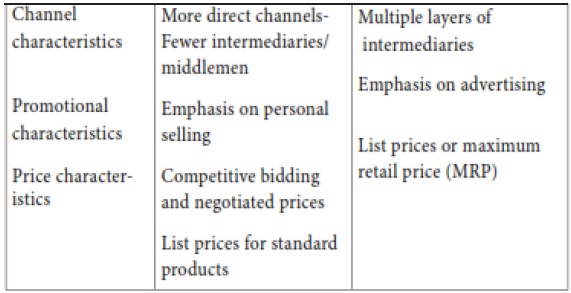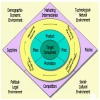MARKETING MANAGEMENT - Introduction to Marketing
Marketing in different sectors - Introduction to Marketing
Posted On :
Until fairly recently, marketing focused primarily on exchanges of goods between individuals (business-to-consumer (B2C) marketing) and businesses (business-to- business (B2B) marketing).
Marketing in different sectors
Until fairly recently, marketing focused primarily on exchanges of goods between individuals (business-to-consumer (B2C) marketing) and businesses (business-to- business (B2B) marketing). A new area of marketing has recently emerged. It is services. Consumer marketing deals with good and services targeted to households for individual consumption. Industrial marketing deals with the organizational purchases of goods to support production of other goods or daily operations or for resale. Services deal with intangible products offered to both consumer markets and industrial markets. Table 1.1.2 highlights the differences between consumer marketing and industrial marketing.
The marketing of services require additional effort. With the growth of the services sector, marketers realized that services cannot be marketed in the same way as the products. Certain characteristics of services posed serious problems for marketers who realized that services marketing must be done differently and not with the same marketing mix (4 Ps) variables. Services have unique characteristics like :

To cope with these challenges,
service marketers broadened the 4-Ps marketing mix to make it 7-Ps marketing
mix. They suggested additional 3 Ps – process, physical evidence and people.
1. The process is aimed at solving the heterogeneity or variability problem associated with the services by providing a service blueprint.
2. The physical evidence solves some of the problems associated with the intangible nature of services. The physical evidence in terms of service environment, equipment, personnel and so on attempts to tangibilize the intangible.
3. The final P – People – gives lot of attention to the service providers because they are, strictly speaking, part of the service provided. They can influence the perceived service quality in a big way.
With the world becoming a global village, marketers started targeting global audience for their products and services. International marketers implement the basic marketing framework discussed earlier. However transactions that cross national boundaries encounter an additional set of environmental factors. For example, differences in laws, economic conditions, cultural and business norms and consumer preferences other demand variations in marketing strategies. The biggest challenge in international marketing is managing the international
Non-profit organizations encounter a special set of characteristics that influence their marketing activities. Like for-profit firms, non-profit firms may market tangible goods and/or intangible services and operate in B2C and B2B markets. An important distinction is that profit-seeking businesses tend to focus their marketing on just one public – their customers. Non-profit businesses however must often market to multiple publics (say, their clients and sponsors), which complicates decision making regarding the markets to target. Also a customer or service user may wield less control over the organization’s destiny than would be true for customers of a profit-seeking firm. As a result, non-profit marketing must fine tune its marketing variables to adjust to these conditions.
Activity 1.1.4
Until fairly recently, marketing focused primarily on exchanges of goods between individuals (business-to-consumer (B2C) marketing) and businesses (business-to- business (B2B) marketing). A new area of marketing has recently emerged. It is services. Consumer marketing deals with good and services targeted to households for individual consumption. Industrial marketing deals with the organizational purchases of goods to support production of other goods or daily operations or for resale. Services deal with intangible products offered to both consumer markets and industrial markets. Table 1.1.2 highlights the differences between consumer marketing and industrial marketing.
The marketing of services require additional effort. With the growth of the services sector, marketers realized that services cannot be marketed in the same way as the products. Certain characteristics of services posed serious problems for marketers who realized that services marketing must be done differently and not with the same marketing mix (4 Ps) variables. Services have unique characteristics like :
1. Intangibility (service firms don’t sell a tangible thing, but a promise)
inseparability (production and consumption of services take place at about the
same time),
2. Heterogeneity (the problem due to the fact that no two service providers are like, nor are the service consumers) and
3. Perishability (service providers cannot maintain inventories of their products).

2. Heterogeneity (the problem due to the fact that no two service providers are like, nor are the service consumers) and
3. Perishability (service providers cannot maintain inventories of their products).


1. The process is aimed at solving the heterogeneity or variability problem associated with the services by providing a service blueprint.
2. The physical evidence solves some of the problems associated with the intangible nature of services. The physical evidence in terms of service environment, equipment, personnel and so on attempts to tangibilize the intangible.
3. The final P – People – gives lot of attention to the service providers because they are, strictly speaking, part of the service provided. They can influence the perceived service quality in a big way.
With the world becoming a global village, marketers started targeting global audience for their products and services. International marketers implement the basic marketing framework discussed earlier. However transactions that cross national boundaries encounter an additional set of environmental factors. For example, differences in laws, economic conditions, cultural and business norms and consumer preferences other demand variations in marketing strategies. The biggest challenge in international marketing is managing the international
Non-profit organizations encounter a special set of characteristics that influence their marketing activities. Like for-profit firms, non-profit firms may market tangible goods and/or intangible services and operate in B2C and B2B markets. An important distinction is that profit-seeking businesses tend to focus their marketing on just one public – their customers. Non-profit businesses however must often market to multiple publics (say, their clients and sponsors), which complicates decision making regarding the markets to target. Also a customer or service user may wield less control over the organization’s destiny than would be true for customers of a profit-seeking firm. As a result, non-profit marketing must fine tune its marketing variables to adjust to these conditions.
Activity 1.1.4
Match the following: | |||
(1) | Product
marketing | - | (A)
AIDS awareness |
campaign | |||
(2) | Service
marketing | - | (B)
Selling iron ore to a steel |
manufacturer | |||
(3) | Consumer
marketing | - | (C)
Selling ice creams to |
adults | |||
(4) | Industrial
marketing | - | (D)
Disney setting up a park |
in Hong
Kong | |||
(5) | International
marketing | - | (E)
Setting up an ayurvedic |
massage
center | |||
(6) | Non-profit
marketing | - | (F) Selling electric bulbs |
Tags : MARKETING MANAGEMENT - Introduction to Marketing
Last 30 days 1545 views













